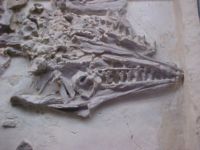|
Pythonomorpha Conservation status: Fossil |
||||||||||
|---|---|---|---|---|---|---|---|---|---|---|

Skull and jaws of the pythonomorphan
Platecarpous at Peabody Museum, Yale
University.
|
||||||||||
| Scientific classification | ||||||||||
|
Pythonomorpha was originally proposed by paleontologist Edward Drinker Cope (1869) as a reptilian order comprised of snakes and mosasaurs. Cope wrote, "In the mosasauroids, we almost realize the fictions of snake-like dragons and sea-serpents, in which men have been ever prone to indulge. On account of the ophidian part of their affinities, I have called this order Pythonomorpha." However, the category was rejected by most 20th-Century herpetologists and paleontologists , who sought, instead, to demonstrate a close relationship between mosasaurs and varanid (monitor) lizards and who generally considered snakes to have evolved from terrestrial, burrowing lizards (see, for example, Russell, 1967). Recently, though, Cope's Pythonmorpha has been revised and resurrected by a number of paleontologists (Lee, 1997; Caldwell et Lee, 1997) who have conducted extensive cladistic anaylses which seem to show that snakes and mosasaurs may be more closely related to one another than either is to the varanid lizards and that snakes more likely arose from aquatic ancestors. As redefined by Lee (1997), the monophyletic Pythonomorpha consists of "The most recent common ancestor of mosasauroids and snakes, and all its descendants." This includes the aigialosaurs, dolichosaurs, coniasaurs, mosasaurs, and all snakes. Lee (1997) was able to show no less than 38 synapomorphies supporting Pythonomorpha.
The etymology of the term Pythonomorpha comes from the Greek Python (a monsterous snake from Greek mythology) and morphe ("form"), and refers to the generally serpentine body plan of members of the clade.
References =
- Caldwell, M. W., Carroll, R. L. et Kaiser, H. 1995: The pectoral girdle and forelinb of Carsosaurus marchesetti (Aegialosauridae), with a preliminary phylogenetic analysis of Mosasauroids and varanoids. Journal of Vertebrate Paleontology 15(3): 516-531.
- Caldwell, M. W. et Lee, M. S. Y. 1997. A snake with legs from the marine Cretaceous of the Middle East. Nature 386:705-709.
- Caldwell, M. W. 1999. Squamate phylogeny and the relationships of snakes and mosasauroids. Zoological Journal of the Linnean Society 125:115-147.
- Cope, E. D. 1869. On the reptilian orders Pythonomorpha and Streptosauria. Proceedings of the Boston Society of Natural History 12:250–266.
- Lee, M. S. Y. 1997. The phylogeny of varanoid lizards and the affinities of snakes. Philosophical Transactions of the Royal Society of London B 352:53-91.
- Lee, M. S. Y. et Caldwell, M. W.. 2000. Adriosaurus and the affinities of mosasaurs, dolichosaurs, and snakes. Journal of Paleontology 74(5):915-937.
- Russell, D. A., 1967. Systematics and morphology of American mosasaurs. Peabody Museum of Natural History, Yale University, Bulletin 23.